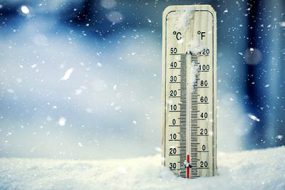
WINTER WEATHER
Winter storms can create a higher risk of car accidents, hypothermia, frostbite, carbon monoxide poisonings, and heart attacks from overexertion. Winter storms including blizzards can bring extreme cold, freezing rain, snow, ice and high winds.
know the terms
Winter Warning: issued when hazardous winter weather in the form of heavy snow, heavy freezing rain, or heavy sleet is imminent or occurring. Winter Storm Warnings are usually issued 12 to 24 hours before the event is expected to begin.
Winter Watch: Alerts the public to the possibility of a blizzard, heavy snow, heavy freezing rain, or heavy sleet. Winter Storm Watches are usually issued 12 to 48 hours before the beginning of a Winter Storm.
Winter Weather Advisory: Issued for accumulations of snow, freezing rain, freezing drizzle, and sleet which will cause significant inconveniences and, if caution is not exercised, could lead to life-threatening situations.
prepare now
- Check emergency kits for humans and pets
- Purchase a NOAA weather radio to monitor conditions
- Avoid unnecessary travel in winter weather and if travel is unavoidable pack your car with supplies necessary if you become stranded (blanket, water, food, first aid kit
- Maintain heating equipment, including annual chimney inspection and cleaning
- Prevent carbon monoxide poisoning by only using vented heat sources and never use grills or generators indoors
- Purchase rock salt or bagged sand for placement on frozen sidewalks to prevent falls
- Use caution if considering to shovel snow if you lead a sedentary lifestyle or have a heart condition
- Keep car gas tank over ½ tank at all times and as full as possible for predicted bad weather
- Bring pets inside during freezing weather
stay safe during
- Stay of roads, if possible
- Limit your time outside
- Avoid carbon monoxide poisoning, Only use generators and grills outside and away from windows. Never heat your home with a gas stovetop or oven
- Reduce the risk of a heart attack. Avoid overexertion when shoveling snow
- Watch for signs of frostbite and hypothermia and begin treatment right away
- Check on your neighbors
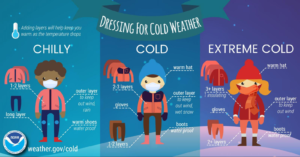
recognize + respond
Frostbite
- Signs: numbness, white or grayish-yellow skin, firm or waxy skin
- Actions: Go to a warm room. Soak in warm water. Use body heat to warm. Do not massage or use a heating pad
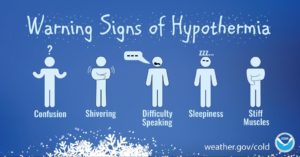
Hypothermia
- Signs: shivering, exhaustion, confusion, fumbling hands, memory loss, slurred speech or drowsiness
- Actions: Go to a warm room. Warm the center of the body first – chest, neck, head and groin. Keep dry and wrapped up in warm blankets, including head and neck
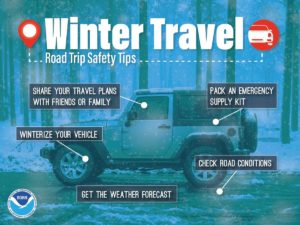
WINTER DRIVING preparedness
-
- Emergency Kit
- Survival blanket
- Road salt
- Shovel
- Scraper
- Jumper Cables
- Drinking water
- Repair kit
- Flashlight
- Flares
- Vehicle Prep
- Fill wiper fluid
- Check tire pressure
- Check tire tread
- Check oil
- Emergency Kit
traveling
- Listen for radio or television reports of travel advisories issued by the National Weather Service
- Do not travel in low visibility conditions
- Avoid traveling on ice-covered roads, overpasses, and bridges if at all possible
- Never pour water on your windshield to remove ice or snow—this can cause your windshield to shatter
- If you must travel by car, use tire chains and take a mobile phone with you
- If you must travel, let someone know your destination and when you expect to arrive. Ask them to notify authorities if you are late
- Check and restock the winter emergency supplies in your car before you leave
- Always carry extra warm clothing and blankets with you. Don’t rely on a car to provide enough heat. The car could break down
outdoor winter safety
Dress warmly and stay dry
adults & children should wear:
- a hat
- a scarf or knit mask to cover face and mouth
- sleeves that are snug at the wrist
- mittens (they are warmer than gloves)
- water-resistant coat and boots
- several layers of loose-fitting clothing
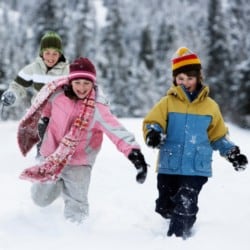
layer up
- Inner Layer: Wear fabrics that will hold more body heat and don’t absorb moisture. Wool, silk, or polypropylene will hold more body heat than cotton.
- Insulation Layer: An insulation layer will help you retain heat by trapping air close to your body. Natural fibers, like wool, goose down, or a fleece work best.
- Outer Layer: The outermost layer helps protect you from wind, rain, and snow. It should be tightly woven, and preferably water and wind resistant, to reduce loss of body heat.
Dress warmly before you go outside in cold weather.
Additional Tips:
- Stay dry—wet clothing chills the body quickly.
- Excess sweating will cause your body to lose more heat, so remove extra layers of clothing whenever you feel too warm.
- Avoid getting gasoline or alcohol on your skin while de-icing and fueling your car or using a snow blower. Getting these materials on your skin will cause your body to lose a lot more heat.
- Do not ignore shivering—it’s an important first sign that your body is losing heat. Constant shivering is a sign that it is time to go inside.
- If you have asthma, breathing in cold, dry air can trigger an asthma attack. Talk to your doctor about how you can prevent asthma attacks when outside in winter weather and remember to follow your Asthma Action Plan.
outdoor activities
- Let your friends and family know where you will be before you go hiking, camping, or skiing.
- Do not leave any areas of your skin exposed to the cold.
- Try not to sweat or become too tired.
- Be prepared to take emergency shelter.
- Pack dry clothing, a two-way radio, waterproof matches, and paraffin fire starters with you.
- Do not use alcohol and other mood altering substances, and avoid caffeinated drinks.
- Avoid walking on ice or getting wet.
- Carefully watch for signs of cold-weather health problems, like hypothermia and frostbite.
if you get stranded
Staying in your car when stranded is often the safest choice if winter storms create poor visibility or if roadways are ice covered. These steps will increase your safety when stranded:
- Tie a brightly colored cloth to the antenna as a signal to rescuers and raise the hood of the car (if it is not snowing).
- Move anything you need from the trunk into the passenger area.
- Wrap your entire body, including your head, in extra clothing, blankets, or newspapers.
- Stay awake. You will be less vulnerable to cold-related health problems.
- Run the motor (and heater) for about 10 minutes per hour, opening one window slightly to let in air. Make sure that snow is not blocking the exhaust pipe—this will reduce the risk of carbon monoxide poisoning.
- As you sit, keep moving your arms and legs to improve your circulation and stay warmer.
- Do not eat snow because it will lower your body temperature.
- Huddle with other people for warmth.
avoid overexerting yourself
Cold weather puts an extra strain on the heart. If you have heart disease or high blood pressure, follow your doctor’s advice about shoveling snow or performing other hard work in the cold. Otherwise, if you have to do heavy outdoor chores, dress warmly and work slowly to avoid excess sweating. Remember, your body is already working hard just to stay warm, so don’t overdo it.
Visit Clean Up Safely After a Disaster for more information on safe cleanup after a disaster.
